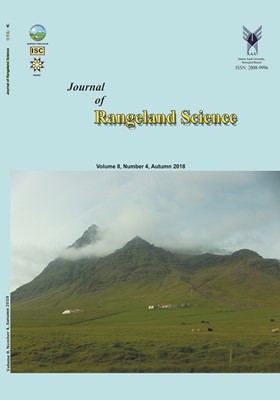Effects of Time and Frequency of Clipping on Production and Regrowth of Agropyron trichophorum (Link) Richt in Emam Gholi Summer Rangelands, Ghochan, Iran
محورهای موضوعی : Analysis and Evaluation
Zeynab Boskabadi
1
,
Kamal Naseri
2
![]() ,
Mansour Mesdaghi
3
,
Mansour Mesdaghi
3
1 - Department of Range and Watershed Management, Faculty of Natural Resources and Environment, Ferdowsi University of Mashhad, Mashhad, Iran
2 - Department of Range and Watershed Management, Faculty of Natural Resources and Environment, Ferdowsi University of Mashhad, Mashhad, Iran
3 - Department of Range and Watershed Management, Faculty of Natural Resources and Environment, Ferdowsi University of Mashhad, Mashhad, Iran
کلید واژه: Grassland, Agropyron trichophorum, Frequency of Clipping, Regrowth, Daily production,
چکیده مقاله :
Pubescent wheatgrass (Agropyron trichophorum (Link) Richt.) is growing in semiarid regions of Iran at altitude of 500 to 2000 m. Among different grasses growing in Iran, A. trichophorum is relatively resistant to grazing and defoliation as compared to other species of Agropyron genus which are dominant in the most summer rangelands. In Emam Gholi protected summer rangelands, Ghochan, Khorasan province, Iran, A. trichophorum as a dominant grass was selected for our study, and was subjected to a series of defoliation treatments. Forty eight quadrates of 0.5 m2 were established in two macro-plots and subjected to one, two, three, and four weekly interval clipping started in May 6, 2016 in vegetative stage and other treatments of once clipping started in May 6, May 19, June 3, and a control treatment was clipped only once in July 15. Floral stalks of A. trichophorum were counted before clipping. Then, quadrates were clipped to the ground surface, air dried and weighed for different treatments. Using ANOVA, the responses to frequent clipping showed that there were no significant differences in daily, current, primary, and total production of A. trichophorum (p>0.05) which may be due to the reservation of carbohydrate in roots and base of this grass after 15 years of protection. Low slope of sigmoid curve for weight of clipped plants also confirmed the resistibility of this species to defoliation, but as the frequency of clippings were increased, the number of floral stalks was decreased showing an exponential model (p<0.0). To find the allowable use of A. trichophorum, further years of research will be required to evaluate the responses to defoliation in different locations.
Abdelsalam. M, Abdalla. N. I, Abdelkreim. M, Elgamri Ibrahim. M, Mohammed. M. M., 2017. The Impact of Continuous Grazing on Natural Rangeland in Alazzazah area- Blue Nile State, Sudan. Journal of Rangeland Science, 7(4): 309-315.
Azimi, A. M, Mozafari. M. 2017. The effects of deferred grazing system on vegetation parameters in semi-arid rangelands (case study: jashlubar, Semnan, Iran). Journal of Rangeland Science, 7(1): 11-19.
Bonvan, M. T., M. Mesdaghi, and A. Malek. 1973. Phenology of native and introduced species at Homand Range Research Station. Publ. by Research Institute of Forest and Rangelands. Tehran, Iran (in Persian).
Briske, D. D., and Richards. J. H., 1995. Plant responses to defoliation: A physiologic, morphologic, and demographic evaluation. In D. J. Bedunah and R. E. Sosebee (Eds.). Wildland plants: Physiology, ecology, and developmental morphology. Denver, CO: Society for Range Management.
Bonham, C.D., 2013. Measurement for terrestrial vegetation. 2ed. ed. John Wiley and Sons, USA.
Caldwell, M. M., Richards, J. H., Johnson, D. A., Nowak, R.S. and Dzurec. R. S. 1981. Coping with herbivory: Photosynthetic capacity and resource allocation in two semiarid Agropyron bunch grasses. Oecologia 50:14-24.
Child, R. D., Heady, H. F., Hickey, W.C., Peterson, R. A. and Pieper. R. D., 1984. Arid and semiarid lands: Sustainable use and management in developing countries. Morrilton, AR: Winrock International Institute.
Cook, C.W., and J. Stubbendieck. 1986. Range research: Basic problem and techniques. Published by Society for Range Management. USA.
Dewey, D. R., 1978. Intermediate wheatgrasses of Iran. Crop Sciences 18: 43-48.
Erfanzadeh, R., Ashrafzadeh, M. Hosseini Kahnuj, S. H., Alizadeh, A., 2014. Preference Value evaluation of rangeland plant species for Kaboudeh sheep. Jour. Rangeland Science, 4(3): 195-202.
Holechek, J. L., Pieper, R. D. and Herbel. C. H., 2011. Range management: Principles and practices, 6th Ed. Prentice Hall Ins. New Jersey.
Houshmand, M., Mesdaghi, S. M. and Sadeghipour, H. R., 2008. An investigation on total nonstructural carbohydrate trends in three Agropyron grasses of Golestan National Park in northern Iran. Proceedings of XXI International Grassland and VII International Rangeland Congress in China.
Mesdaghi, M. 2015. Range management in Iran. 3ed ed. Publ. by Sadjad Industrial University, Mashhad, Iran. 326pp (in Persian).
Niknahad Gharmakher. H, Jafari Foutami, I, Sharifi, I., 2015. Effects of Grazing Exclusion on Plant Productivity and Carbon Sequestration (Case Study: Gomishan Rangelands, Golestan Province, Iran). Journal of Rangeland Science. 5(2): 122-134.
Rashvand, S., Yeganeh, H., Bakhshadh, M. Amiri, F., 2017. Determining the preference value of perennial grasses using preference index and sheep grazing time methods in grasslands of the middle Alborz, Iran Jour. Rangeland Science, 7(1): 1-10.
Vallentine, J. F., 2001. Grazing management. 2nd ed. New York: Academic Press, Inc.
Zohary, M. 1973. Geobotanical foundations of the Middle East. CRC Press, New York. 756 pp.


